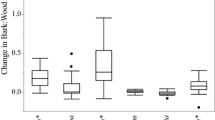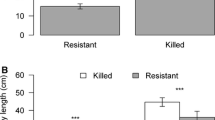Abstract
Bark beetles (Coleoptera: Scolytidae) are commonly associated with live host trees that are stressed, a relationship that has been attributed to lower host defenses or greater nutritional quality of these trees. However, most bark beetle species commonly inhabit freshly dead trees where induced host defenses are absent. In this study, we investigate the role of tree vigor at the time of death for pine engraver bark beetles, Ips pini (Say), breeding in freshly dead jack pine, Pinus banksiana Lamb. As indices of tree vigor, we considered tree size, phloem thickness, and several measures of recent growth rate (last year's growth increment, mean annual increment and basal area increment in the past 5 and 10 years, and periodic growth ratio). We examined the relationship between these indices in three stands, aged 60, 77, and 126 years, and found that phloem thickness, previously shown to have a strong positive effect on bark beetle reproduction, was only weakly associated with tree growth rate and inconsistently related to tree size among the three stands. To examine the effects of tree vigor on pine engraver reproduction, we felled 20 trees of various sizes from the 77-year-old stand, and experimentally established breeding males and females in 25-cm-long sections. Offspring were collected and characteristics of breeding galleries were measured. Using stepwise regression, we consistently found that indices associated with tree growth rate best explained beetle reproductive performance, as they were positively related to parental male and female establishment on logs, female reproductive success, length of egg galleries, proportion of eggs resulting in emerged offspring, and negatively related to the length of the post-egg gallery. Surprisingly, phloem thickness had no unique effect on pine engraver reproduction, except for a weak negative effect on the establishment success of parental females. The strong effect of tree vigor observed in this study suggests that substantial mortality of vigorous trees, such as caused by windthrow, can contribute to significant increases in bark beetle populations that could trigger outbreaks in living trees.
Similar content being viewed by others
Author information
Authors and Affiliations
Additional information
Received: 3 February 1999 / Accepted: 27 April 1999
Rights and permissions
About this article
Cite this article
Reid, M., Robb, T. Death of vigorous trees benefits bark beetles. Oecologia 120, 555–562 (1999). https://doi.org/10.1007/s004420050890
Issue Date:
DOI: https://doi.org/10.1007/s004420050890




